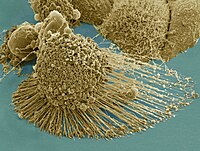
Photo from wikipedia
Abstract Primary ciliary dyskinesia is an inherited, currently incurable condition. In the respiratory system, primary ciliary dyskinesia causes impaired functioning of the mucociliary escalator, leading to nasal congestion, cough, and… Click to show full abstract
Abstract Primary ciliary dyskinesia is an inherited, currently incurable condition. In the respiratory system, primary ciliary dyskinesia causes impaired functioning of the mucociliary escalator, leading to nasal congestion, cough, and recurrent otitis media, and commonly progresses to cause more serious and permanent damage, including hearing deficits, chronic sinusitis, and bronchiectasis. New treatment options for the condition are thus necessary. In characterizing an immortalized human bronchial epithelial cell line (BCi‐NS1.1) grown at an air‐liquid interface to permit differentiation, we have identified that these cells have dyskinetic motile cilia. The cells had a normal male karyotype, and phenotypic markers of epithelial cell differentiation emerged, as previously shown. Ciliary beat frequency (CBF) as assessed by high‐speed videomicroscopy was lower than normal (4.4 Hz). Although changes in CBF induced by known modulators were as expected, the cilia displayed a dyskinetic, circular beat pattern characteristic of central microtubular agenesis with outer doublet transposition. This ultrastructural defect was confirmed by electron microscopy. We propose that the BCi‐NS1.1 cell line is a useful model system for examination of modulators of CBF and more specifically could be used to screen for novel drugs with the ability to enhance CBF and perhaps repair a dyskinetic ciliary beat pattern.
Journal Title: American Journal of Respiratory Cell and Molecular Biology
Year Published: 2018
Link to full text (if available)
Share on Social Media: Sign Up to like & get
recommendations!